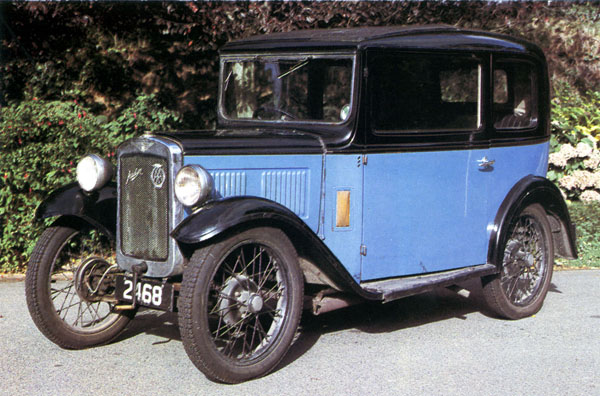
1934 Austin Seven
With the exception of the Model T Ford, which was produced in even greater quantities,
the Austin Seven probably introduced more people to motoring than any other car.
Certainly, after its introduction the market for motorcycles took a dive as people found
an alternative means of transport which was not only economical but much more
comfortable.
The fact that these cars were also amazingly long-lasting meant that through the
second-hand car market many more people could enjoy motoring in an even cheaper
second-hand Austin Seven. More than a quarter of a million people bought Austin
Sevens.
Although the first Sevens had a 696 cc engine, by the time that production got fully
underway in 1923 the four-cylinder in-line, side-valve 747 cc unit was standard. This
engine had a bore of 56 mm, to keep the taxable horsepower rating down to an
acceptable level, and because of this the car had to have a long stroke – 77.2 mm in
the 747 cc unit which gave it a lot of torque and meant it was understressed and so
lasted a long time.
The car itself was very cheaply made and had no engine oil pump with lubrication of
moving engine parts being achieved more by good luck than good design. Indeed,
simplicity was the key to the Austin Seven’s low price, with equipment confined to the
bare necessities. To advance or retard the ignition a large lever was attached to the
steering wheel boss.
The chassis, like the engine, continued the concept of cheap and simple construction. It
employed two steel girders with a central brace to form the letter `A’ shape. Springing
was by elliptic springs and the whole car flexed considerably, swaying from side to side
whenever one of its wheels struck a bump. It required real skill in handling, obtained by
constantly turning the steering wheel in a see saw motion in rhythm with the road
surface. In an effort to improve the handling the wheelbase was extended by 150 mm
in 1932.
It had a tiny open body with two seats at the front and a bench at the back for children,
or anything else that the driver desired to carry. These cars earned the nickname
Chummies because their occupants had to be on very good terms with each other to
squeeze into the tiny body. Towards the end of the model life the car became available
with a variety of body types, including saloon and van.
The Austin Seven was one of the first cars to have brakes on all four wheels. This was
not of any great advantage however as they did not work all that well. At the time the
law decreed that all cars must have two completely independent braking systems so
the Austin Seven had back wheel brakes operated by foot and front wheel brakes
operated by a hand lever using cheap and inefficient cables and levers. To overcome
objections the company maintained that good brakes led to bad driving habits, a tenet
which people who knew no better were happy to accept.